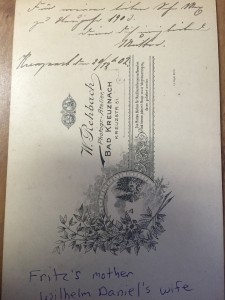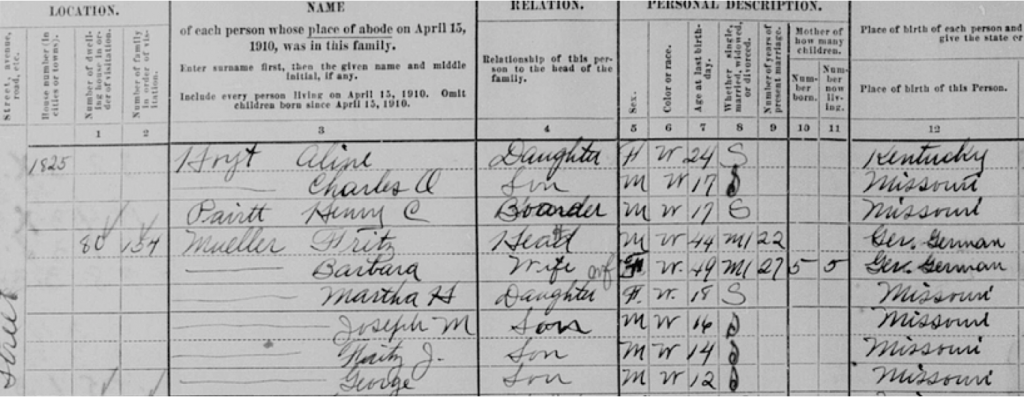Number One Rule in Genealogy: Start with what you know, and document, document, document! Although you may think you know the name of your immigrant ancestor, expert genealogists say you should never start off with looking for him or her in Europe – instead, start with yourself (after all, who do you know better?) and go back from there, generation to generation, documenting your sources along the way.
Why all this work? Well, you may think your immigrant ancestor was Wilhelm Müller from Germany, but do you know how many Wilhelm Müllers existed? You need to be 100% sure you are looking for your Wilhelm – in the exact right time frame and geographical region – so as not to waste your time doing another person’s research! Even those less common names were more common than you might think. But where to start? Below, a list of 5 great places to find your ancestors in America before your cross the pond:
- Home Sources
Looking in your basement, your attic (or another relative’s basement and attic) can often turn up genealogical treasures. Letters and diaries of family members are amazing sources of information, and you never know what your grandma or grandpa ended up saving. Old photographs can provide you with clues – turn them over, and you may find names and ages of the subjects on the back. You may also find the studio where the photograph was taken, a great hint for where to continue your genealogy search. Family bibles can also be great sources – birth, marriage and death dates would often be written inside the front cover. And, finally, and perhaps most importantly, people – go find your oldest living family member now and ask to interview them. Talk to them about their parents, their grandparents, their aunts and uncles and their family stories. Besides giving you information for your genealogical search, hearing stories from the past is just plain interesting! I recently interviewed my own grandmother and learned about her life growing up in the 1930s. Check out her story Fly Soup, German Spies and Stolen Blue Jeans: A Glimpse into the 1930s with Grandma, here.
These photos were found in my grandmother’s house. If we turn them over, we can see the name of a photo studio on the back (This studio is in Germany, but the same could be true for American photos.)
- Vital Records and Church Records
Vital records and church records can provide a great deal of information about your ancestors’ lives. Vital records offer birth, marriage and death dates, while church records provide this information and possibly more (sacraments). Where can you find these records? To name just a few places:
- Family Search
- Ancestry
- State and County Archives
- Local churches where your ancestor lived
(If you are looking for a translation of the common vital records from Germany, I am now offering downloadable birth, marriage and death certificate translation templates, complete with the German transcription and English translation of all printed words on the form, in my online shop.)
- Census Records
The census has been taken every ten years in the US since 1790. Because of privacy laws, the most recent census available is the 1940 census. The census can provide you with treasure troves of information, including your ancestor’s name, family members’ names, ages in that year, immigration year, occupation, language spoken and more. Where can you find census records?
- archives.com
- HeritageQuest Online
- Fold3
- USGenWeb Archives
- Family Search
- Ancestry
- County Courthouse
- State Archives
This 1920 census from Missouri offers information about my great-great-grandfather. It was found on familysearch.org.
- Ethnic Newspapers
When our ancestors moved to America, they often formed German-speaking communities in order to feel like they had a bit of their homeland in their new country. These communities often had their own newspaper, reporting on the events and stories relating to their community members. A newspaper from your ancestor’s community might mention your ancestor, along with a piece of information you might known have known about him or her – perhaps an address, a parent’s name, a siblings name, etc. Check out great collections of ethnic newspapers at:
- Genealogy Bank
- County Libraries

Westliche Post was a German-speaking newspaper published in St. Louis. It can be found at the St. Louis County Library.
- Passenger Lists
New York, Philadelphia, New Orleans and Baltimore were all ports of entry for our ancestors coming to the US. Their passenger lists can provide you with your ancestor’s birthplace, the date they arrived in America, the name of the ship they traveled on, their occupation, a description of how they looked, their most recent place of residence, and more – a wealth of information for the interested genealogist. Where can these lists be found?
- castlegarden.org
- ellisisland.org
- stevemorse.org
- passengerlists.de
- Family Search
- Ancestry
- National Archives
- “Germans to America” Book Series
These are just a few ideas of where to start looking for your German ancestor. Other sources (naturalization records, military records, etc). can also help you in your genealogy quest. And once you make it back to your immigrant ancestor and are ready to cross the pond, feel free to contact me here for any German language translation you may need for those documents. Happy hunting!
Source:
The Family Tree German Genealogy Guide, by James Beidler
Image Credit:
http://americanhistory.si.edu/onthewater/exhibition/5_2.html





One Response
Here a summary of Dr. Roger P. Minert’s findings over a 10-year period of searching out people’s German roots: where he most often located a German immigrant’s place of origin
https://www.familysearch.org/blog/en/tracing-german-american-immigrants/